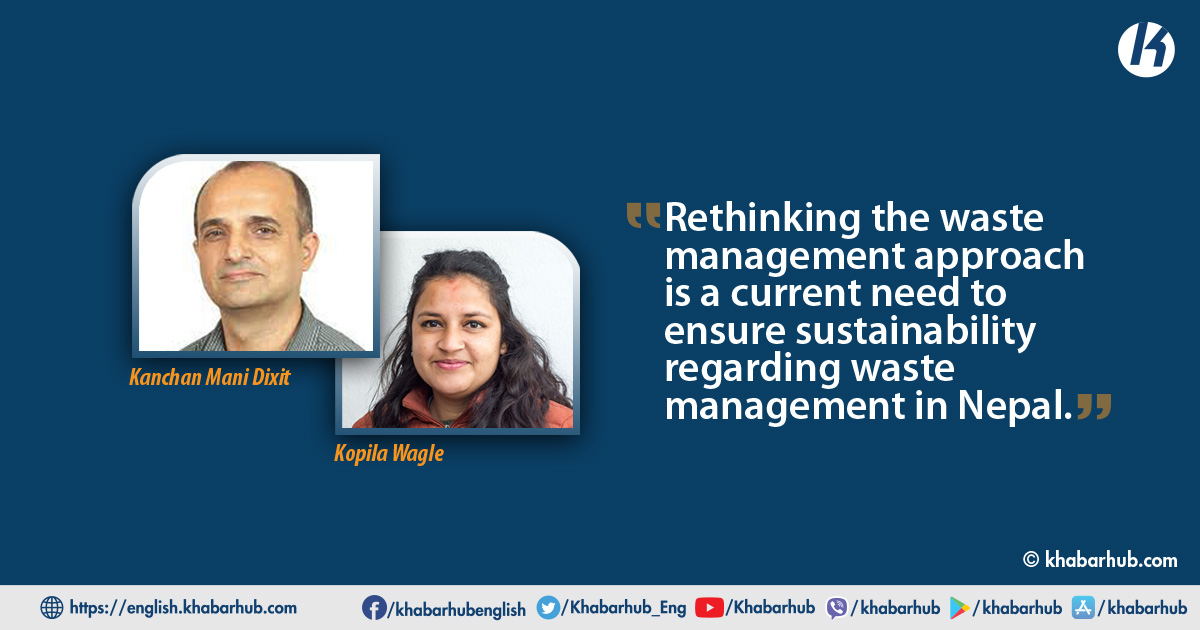On June 3, 2021, just two days before Environment Day, a fire broke out at the waste transfer center at Teku. The transfer station, operated by the Kathmandu Metropolitan City, is located on the banks of the Bagmati River.
Footage of the fire, shared on the media, showed that it was huge and took the effort of Nepal police, armed police force, fire brigade, and Nepal Army to extinguish.
The fire was severe for two reasons: first, all kinds of waste, including plastics and rubber, were burning (the dark black color of smoke points in that direction), polluting the environment with harmful chemicals and smoke.
Second, the methane gas from the decaying waste help spread the fire quickly. In addition, the waste collection center at Teku, being in the middle of the city, poses much threat to the residents nearby with the foul smell, risk of transmission of communicable diseases, air pollution, and fire risk.
The medical waste from many hospitals also gets dumped on the site, risking residents’ lives and the marginalized people who come there to collect plastics to make little money.
When the waste at the Teku collection center was on fire, the question immediately came to us that what it would be if the Sisdol landfill site catches on fire. Kathmanduties and other city residents have not yet forgotten the wildfire that encompassed the whole of the country from January to April 2021.
The smog blanketed the cities and villages across the country, making it difficult for people to breathe. The long dry spell due to climate change triggered this fire.
We can foresee this type of event in Sisdol that can affect bordering municipalities and people living in them. Fire in waste facilities is comparatively difficult to extinguish and has a severe impact on the environment.
In Norway in 2014, fire in waste collection centers came under control in 36 hours, even with their advanced technology.
In Sweden, in 2016, fire at the collection center was too big to control using water and chemical extinguishers, so they used sand.
About 7,000,000 kg of sand and 1,000,000 kg of gypsum were used to cover the 6,000,000 kg of waste. It shows that extinguishing waste fire requires enormous effort both in terms of monetary and environmental costs.
Sisdol falls in Kakani Rural Municipality of Nuwakot District. The 15-hectare area is used to dispose of wastes generated in Kathmandu and Lalitpur metropolitan cities and the adjoining municipalities of the valley.
The landfill site came into operation on June 5, 2005. An original plan to use the landfill site was one to two years. However, the practice of dumping waste in Sisdol continues until this date.
The dumping site started to grow as the government acquired additional lands. Local people also leased their land to the government as living near the site became impossible due to the foul smell. About 1,200 tons of waste are dumped daily on the site.
The gases released from the burning of all kinds of pollutants, including plastics, rubber, styrofoam, leathers, and almost every disposable thing we use, are harmful to the people living in the area and other parts of Nepal.
Often, carcasses land into people’s homes through eagles, dogs, hawks, and crows increasing the risk of diseases and creating annoyance.
The medical waste from many hospitals also gets dumped on the site, risking residents’ lives and the marginalized people who come there to collect plastics to make little money.
Had there been a medical test of these people, the diseases manifested from the waste would have come to notice.
In addition, the leachate directly mixes at the Kolpu stream, creating a health hazard to the settlement downstream.
Now that the whole country is suffering from damage due to excessive rainfall, it is evident that the leachate would mix with the river water downstream, loaded with millions of disease-causing vectors and bacteria. The bitter truth is that the water from Kolpu is used for drinking, washing, cattle, and irrigation.
Even though the landfill site is far from human settlement, fire in the site can have multiple effects on people and the environment.
First, the leachate has already reached the river downstream and polluting the surface and groundwater. Studies have shown that the leachate at the site contains heavy metals such as arsenic, iron, copper, cadmium, chromium, lead, and nickel.
If mixed with ground and surface water, it causes health hazards. Communities also face health-related problems due to the waste being a breeding ground for different diseases. It also generates a high level of methane gas, contributing to global climate change.
Second, the level of air pollution would be huge, with thousands of tons of waste burning. Fire brigades reaching the site is also difficult with too many wastes piled up, and waste fires in other countries have shown that using fire bridges would not work.
With the Sisdol exceeding its carrying capacity, the government is developing a landfill site in Bancharedanda of Kakani, Nuwakot, about three kilometers northwest of Sisdol.
Third, the years of waste deposition and methane formation make the fire spread quickly, posing a risk to the whole ecosystem.
The gases released from the burning of all kinds of pollutants, including plastics, rubber, styrofoam, leathers, and almost every disposable thing we use, are harmful to the people living in the area and other parts of Nepal.
What we require now is an alternative to Sisdol. The alternative, we mean here, is not finding another place to discard waste once it has reached its carrying capacity but exploring ways to recycle waste to produce consumable goods, energy, and manure.
We cannot deny that the present rate of modernization and extensive use of disposable things would continue increasing solid wastes.
The conventional waste management practices of waste collection, segregation, transport, and disposal to landfill sites is outdated as it affected people and the environment.
Today, new forms of ideas have emerged, and the concept of circular economy is getting popular. Waste can be a precious part of our economy. We can learn from other parts of the world where people have generated electricity from wastes.
There are many other options too. So why are we not going in that direction? The lack of political will that people have witnessed for years is the culprit for sustainable waste management in Nepal.
Now that the government structure has changed, providing decision-making rights to every rural and urban municipality to implement their innovation, these options should be explored by the local governments.
With the Sisdol exceeding its carrying capacity, the government is developing a landfill site in Bancharedanda of Kakani, Nuwakot, about three kilometers northwest of Sisdol.
Are we again following the outdated waste management approach and looking for a new site when Bancharedanda exceeds its carrying capacity?
About 63 percent of the waste generated from households is organic that can be managed by households using composting and vermicomposting. The non-degradable wastes such as glass, metals, and plastics can be recycled.
It is just that government should develop innovative packages that provide incentives to the households to recycle wastes at home.
Now that the government structure has changed, providing decision-making rights to every rural and urban municipality to implement their innovation, these options should be explored by the local governments.
It is also true that, unlike Kathmandu, many of the local governments do not have open spaces to use as landfill sites.
Therefore, rethinking the waste management approach is a current need to ensure sustainability regarding waste management in Nepal.
(Kanchan Mani Dixit, Executive Director at ISET-Nepal, has a long experience working in environmental issues; and Kopila Wagle is a student of Environmental Science and researcher at ISET-Nepal)









Comment